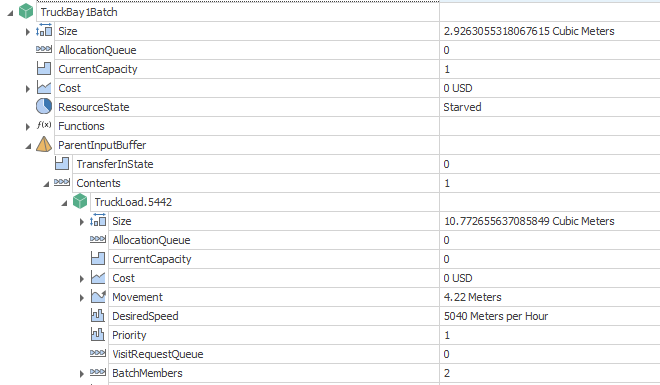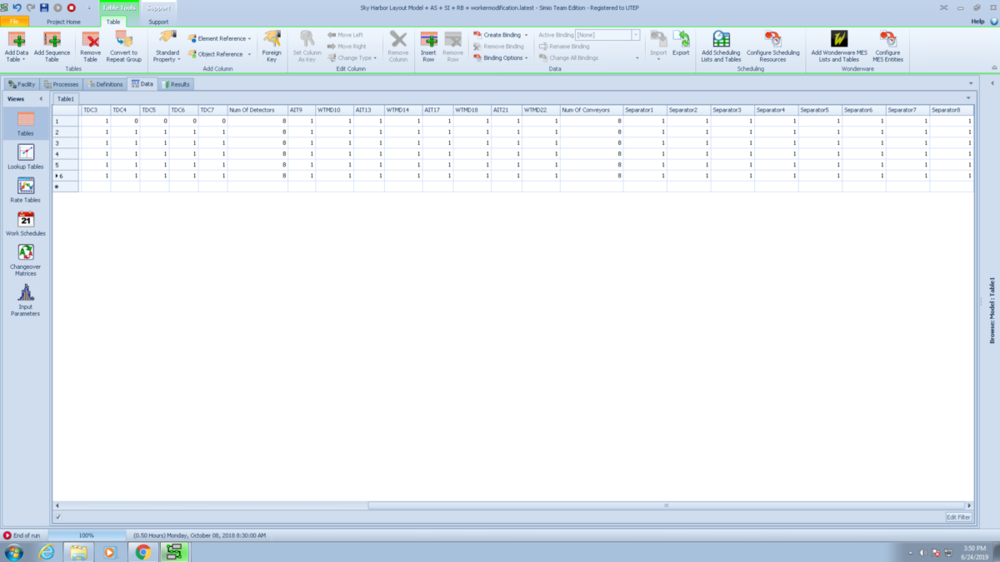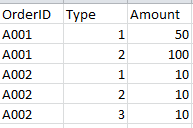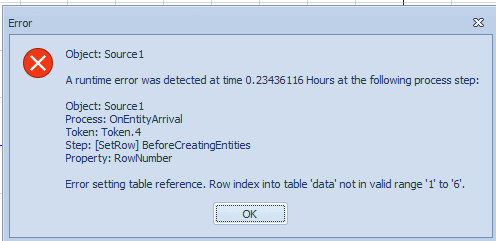Search the Community
Showing results for 'object reference'.
-
Hi, can I get an object reference from a string with its name? Thanks!
-
Hello everyone, I am trying to add a new property for a Server object, which would be a string. For instance, the property needs to be something like "Type of Patient" (that each server can attend). I created a property within the Server's subclass, but it does not work. ¿How can I define a new property for a certain object? Thanks in advance, Marcel Favereau
-
Hi Indsiders, after 30 hours of simulation i get this error message from a DB Write Step: Exception from Step "StepName" execution.Object reference not set to an instance of an object. I dont know why i get this error, cause all entities before where able to execute this step. Is someone able to give me an adivise with this informations ? Beste regards, Benjamin
-
Rotary filler head object that represents animation of bottles rotating around a cylinder as they get filled. You can use a regular server if animation is not required. This object lets you define the number of filling heads, direction of rotation and rate (Bottles Per Minute), pitch of fillers heads (in degrees) and ReleaseType (Release type represents where the bottle will be released at 180 Degree from the start point or 270 degree). As seen in the picture above, Arrow represents the starting point. Users can also specify if they need fine control over the rotation of the filler heads. If fine control is set to True filler head will pitch by 1 degree. This provides smoother animation.Users will have to make sure the pitch is set correctly in relation to the release type if Fine Movements are set to False. With FineMovements set to False filler heads movement is equal to pitch defined. Users can also specify failure rate in similar way to server or other standard Simio objects. This object has not been extensively tested and it can be further customized to requirements. IndexingPlate - V4.spfx
-
A basic photo eye object that can be used with conveyor belts. Photo eye is based on a transfer node object. It collects statistics on time in blocked state, cleared state and throughput. Transfer nodes on entered and on exited add on processes can be used as on blocking and on clearing add on processes. Photo eye has properties to define the delays for on blocked and on cleared. Photo eye will wait to complete on blocked delay to execute on blocked add on process. Similarly, photo eye will wait to complete on cleared delay to execute on cleared add on process. PE_Library.spfx
-
I have a multiple combiners into which a single worker provides entities. While the worker is at a specific combiner, I want to check if that combiner's output buffer is full. I'd prefer not to create a separate process for each combiner as I have dozens. How do I code the process so that it is generic and that 1 process can work for any combiner? I'm hoping this is an easy question. Sorry if it's obvious. Thanks for your help.
-
I think the title is pretty straight forward, but is there any way to utilize a reference state to then concatenate onto a string? I have a large number of states I'm tracking and they're all a function of the EntityType itself. So for the sake of efficiency I was hoping I could somehow take advantage of the reference but so for no dice considering they're 2 completely different states. Any tips/tricks I'm just not thinking of?
-
Hello Everyone, please can someone help me with this situation? I want to use a Server as a storage place, entities coming out of it go into the MemberInput of a Combiner. I want the number of entities that leave the Server to depend on the state of the entity that will enter the ParentInput of the Combiner. How can I access the state of the parent entity that will enter the combiner from the Output Node of the Server? Thank you very much, Greetings! 14.10.spfx
-
I am trying to set up a custom object subclass for a conveyor that emulates an accumulating conveyor which has configurable "zone" lengths and overall lengths. Zones can be equated to "cells" in Simio. For example, if I have a 6' long conveyor with 12" zones, then I would have QTY 6 zones on the 6' long conveyor, which means a traveler capacity of 6 and a cell count of 6. For a 6' conveyor with 24" zones, I would have QTY 3 zones, traveler capacity of 3 and cell count of 3, and so on. In my custom object subclass, I have custom properties for the conveyor length and zone length. I have a function that calculates the traveler capacity based on this. The issue I am having is setting the initial traveler capacity and fixed cell count properties to reference the output of this function. The problem is two fold: 1) How do I create a default property value that references another property or function within the same object instance? For example, say my object subclass is called "Conveyor_Custom" and my capacity calculation function is called "CapacityCalculation". I am able to reference the function output by typing Conveyor_Custom1.CapacityCaculation in the property pane of the first object instance (which is Conveyor_Custom1) on the main model, but I have to type this out for each instance that I create (ie. Conveyor_Custom1, Conveyor_Custom2, etc.). I am looking for a way to set the default value for the entire object subclass to reference the calculation from it's own instance. This default would need to be set within the object definition itself, so that I could drop many instances of the object into the model without needing to type in the name of each instance into the property pane manually. For example, something like Self.CapacityCalcuation would be great, but I am not sure there exists a generic self-reference placeholder and I can't find it in the documentation. 2) Even when I type in the capacity calculation reference manually for each object instance, I still get an error for the NumberOfCells property. For example, in the main model, in the property pane for the first object instance, I can manually set the InitialTravelerCapacity to Conveyor_Custom1.CapacityCalculation and get the correct value returned with no errors. However, when I set NumberOfCells to Conveyor_Custom1.CapacityCalculation, I get the error "Invalid numeric value". The output of the function is an integer (I have some rounding in there to make it so) so I am not sure why the value is invalid. I also tried setting it to Conveyor_Custom1.InitialTravelerCapacity and this also throws the same error. It would be convenient to be able to set the traveler capacity and cell count to the same value, since on accumulation conveyors with defined zone lengths, this is the real physical situation. It doesn't make sense for me to have to manually calculate this and input the actual integer value when there is already a function set up to do this and other properties are able to reference the output of that function. If anyone has experience with this please let me know, in the meantime I am doing it manually but it is very tedious. Thanks!
- 2 replies
-
- properties
- subclass
- (and 16 more)
-
Hello!
In reference to your question "How to use Simio as an external simulation routine (respectively, how to control Simio from other software e.g., R)?", did you figure out an answer that suited your needs?I saw that your question post in SI General Discussions received a post from lstretton. What was the follow-up on that? I am unsure of where to go to get further information on the steps for that. I'm new on the forum.
My problem seems to run in line with yours. I have data that populates an excel csv file and I want to import that into Simio for my simulation. Eventually I would like to automate the runs of a bunch of difference replications, potentially with R or Python or something like that.
Thanks, ftiller
-
Hi all, I am working on a building evacuation project through Simio. I want to know how can I block a sink object, so entities can not exit through that sink. I also need to know if I can somehow define this situation in referenced property under Experiment and try different scenarios. For example in each scenario I block one of the exits and monitor the number exited (survivors) or evacuation time. My other problem is simulating fire with different rates and interaction of it with the entities, as when they see fire they avoid running toward that direction and change the route. Thank you for your help,
-
I have developed this Stacking object that I am using to model Container Stacking for reach stackers and Toggle on/off for straddle's. It also automatically un stacks itself if the container needed is below others StackingObjectDemo.spfx
-
I would like to reference state values associated with objects within a data table. For example, suppose I have a Data Table, call it Tab1, with an Object Reference column called Obj. The first entry in the object reference column is a resource called Res; thus, Tab1[1].Obj points to Res. How do I access the value of Res.CurrentCapacity using the table reference? To make this a little more complex, what if the state were a vector of integers? Thus, what I would like to reference would be something like Res.vector1[1].
-
Hi - Let's say I have two objects Object1 and Object2 in my project. In a model I have one instance of Object1 as Object1_01 and another instance of Object2 as Object2_01. Is there any way I can access the variables values of Object1_01 from Object2_01. I tried to define an ObjectInstanceProperty in Object2 and set it to Object1_01 for Object2_01 instance but its not working. Any ideas that can solve this issue? Thanks Zaki
-
Sorry if this is obvious, but can someone tell me how I can reference the number of batchMembers in the example above without having to reference the specific entity, which in this case is TruckLoad.5442. I need something like "the number of batchMembers in the entity currently in the ParentInputBuffer" please. e.g. TruckBay1Batch.ParentInputBuffer.Content.???.BatchMembersCount? As you'd expect, this number changes constantly during the simulation run. At this moment of simulated time, the answer is 2. Thanks for your help!
-
Hello, This model corresponds to an assembly line for three models. ModelA and ModelB are processed from Station1 to Station9 and the leave the line. ModelC must have additional work, which is to be done in Auxiliar (in between Station 8 and Station9), so that it leaves the line after Station 8and gets back to Station9 after the extra operations. A sucbomponent must be ordered in advance to be integrated to ModelC in Auxiliar. The logic I want to implement is the following. I have a list containing all stations (object list lstStations). A list property pointint to that list (rpSynchroStation). For every output node of every station, I want to check if the list property coincides with the name of the corresponding station (and if it's model C in that station). If so, an event is triggered, and a source corresponding to the supplier produces a part that will be delivered some time later. The problem I am having is within the decide step, when comparing: ModelEntity.Location.Parent.Name == rpSynchroStation && ModelEntity.EntityType == ModelC In Decide2 step in procCheckIfSynchro process. I get an error when comparing ModelEntity.Location.Parent.Name == rpSynchroStation. Could you please help me with this? Many thanks Best regards, model_tractors.spfx
-
I have a project where I would like to see snapshots of the output state of the system at specific time points. For example I would like to see output reports at 12, 24, 36, 48 hours and so on. Ideally I would like to set up experiments where I can observe, say 100 runs at each run length and saving capacity on my PC might be nice. I was thinking I could set up a reference property for Run Length; however, it does not seem to have that option. Is there a way to do something like this? Thoughts would be appreciated! Thanks, Jim
-
Hello, this is probably a trivial question but I've already read a lot of material and tried a lot of things but I've been unable to do what I need. I have a Top Model which represents the general view of my facility, and a submodel consisting of a Workstation and some additional logic of combiners and separators. This submodel represents a machine that I want to instantiate in my Top Model multiple times. Now, I'll need to assign an operator present in the Top Model to perform the setup and teardown steps in my Workstation. And so, I've tried to reference the Secondary Resources, so I can assign the operators in the top model. But referencing the secondary resources it does not seem to work since the top model does not get access to the subfields in the Secondary Resources (Object type, Object Name etc.). I've also tried to individually reference each subfield but this also does not seem to work, since the referenced subfields do not seem to be part of the Secondary Resources Repeat Group. Which is the cleanest way to achieve want I want? Thank you in advance, Pedro Prates
- 3 replies
-
- workstation
- secondary resources
- (and 3 more)
-
Hello, I have been utilizing SIMIO for a couple of months, but I am still relatively new to some of the features and I recently encountered a difficulty that leads me to the following question. Is it possible to include an entire table in the model as a reference property in an experiment? I have a Table that controls the capacity of all servers at specific intervals within the simulation time, but I would like to include a warm up period in my simulation. The only manner I encountered to make this possible is through an experiment. The attached picture shows the Table, but there are too many parameters to reference them individually. If not possible, or perhaps an easier solution, is there a manner to include a warm up period in the simulation without having to perform an experiment? I would only like to take the model into a steady state prior to collecting statistics, but a need does not necessarily exist for me to perform an experiment.
-
Hi, How can I check if an object refernce state is null? I tried "state.is.null" and "state == null" but both did not work. Thanks,
-
I have 3 servers called Sever1, Sever2, Sever3. Sever1 processes Type1 Entity, Sever 2 processes Type2 Entity, and Server3 processes Type3 entity. (i.e: there are 3 sources to generate 3 different ModelEntity) In the scheduling table, for the first order A001, Type1 and Type2 are needed but not Type3. For the second order A002, Type1, Type2, and Type3 are all needed. How do I make reference in the table such that at any time point, all 3 servers Sever1, Sever2, and Sever3 only process 1 orderID? Also, I would like to know if it's possible to view the states of different instances of an Entity Object. If it is possible, how can I do so?For example, I create Entity1 at the source. During the simulation run, there will be many instances of Entity1. Can I view the user-assigned state values of these different instances, at different points during the simulation run? Please do help me to clarify the question if my wording is not clear enough. Thank you!
-
In my model, entities are created representing each row in a data table at the source. At creating, the entities are assign to a row in the data table. The entities are created and assigned the right data until the last row of the table is created and then I get this message "Error setting table reference" and the simulation stops. How do I set the model to stop creating entities when the last row is created? Thanks in advance! SampleModel2.spfx
-
I have 3 questions: 1) I have a data table, each row representing an entity to be created. I create several entities and assign each of them to each row in this data table, using a SetRow Process. I have read somewhere that after I set a row to an entity, it becomes or token? So what is a token exactly? 2) Also, after a created entity is set to a row in the data table, is there any special syntax I can use to make reference to values in other columns in this row? Or I still need to keep track of which row in the data table the entity is set to and make the references using the normal table referencing syntax accordingly? Thank you !
-
Greetings! I have this problem and I'm probably doing something wrong. I'm trying to use the Find Step to make my entities look for the closest server through the DirectDistanceTo Expression. This Process is triggered when the entity enters a Transfer Node. Based on these screenshots, can you tell me what am I doing wrong? I'm almost certain the Search Expression is incorrect. Thanks!
-
I have created a new reference property for the combiner batch quantity in the combiner logic. Is there any way I can set that same reference property as a column of a data table so that I can change that value based on the type of the entity ?











